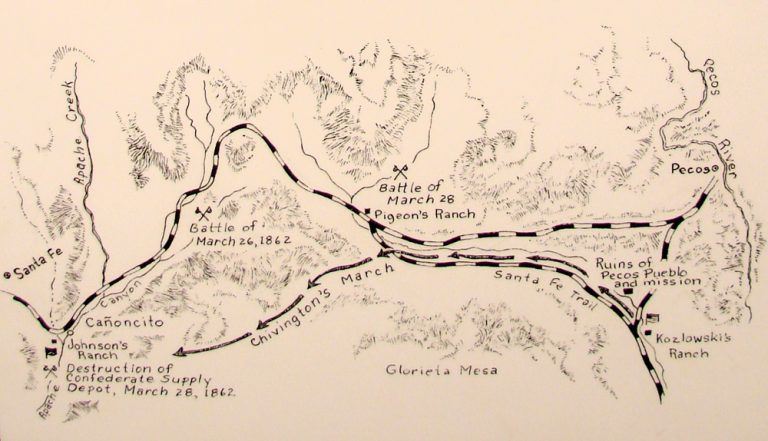
The Battle of Glorieta Pass ranged through a narrow mountain divide in the Sangre de Cristo mountains just east of Santa Fe on March 26-28, 1862. The pass was part of the Santa Fe trail that had connected Old Santa Fe to Franklin, Missouri for nearly half a century. The three ranches involved in the battle were also used as way stops along the trail. Three very different characters owned and operated the ranches.
Union troops were headquartered at a ranch on the eastern end of the pass that was owned by a Polish immigrant named Kozlowski. You can read more about him and his ranch here.
The Confederate base was at Johnson's ranch, located at the western mouth of the canyon.
Union troops were headquartered at a ranch on the eastern end of the pass that was owned by a Polish immigrant named Kozlowski. You can read more about him and his ranch here.
The Confederate base was at Johnson's ranch, located at the western mouth of the canyon.
 Pigeon's Ranch in the 1880s.
Pigeon's Ranch in the 1880s.Between Kozlowski's and Johnson's place sat Pigeon's ranch, which operated a hotel and saloon and was a popular watering hole along the trail. Pigeon's Ranch was the frequent venue for fandangos, the local dances.
Pigeon's ranch was owed by a French immigrant whose very name is a matter of speculation. Some records list him as Alexander Pigeon. Some sources, however, say that Pigeon was a nickname he received because he strutted and flapped his elbows when he danced, making him look rather like a pigeon. On some documents, he is named Alexander Valle. Some historians suggest that Valle is less a surname as a placename given to him because his establishment was in the center of the valley. Both Pigeon and Valle are names that can be found in France, so either may be the man's actual name.
Pigeon's ranch was owed by a French immigrant whose very name is a matter of speculation. Some records list him as Alexander Pigeon. Some sources, however, say that Pigeon was a nickname he received because he strutted and flapped his elbows when he danced, making him look rather like a pigeon. On some documents, he is named Alexander Valle. Some historians suggest that Valle is less a surname as a placename given to him because his establishment was in the center of the valley. Both Pigeon and Valle are names that can be found in France, so either may be the man's actual name.
 An old postcard showing Pigeon's Ranch.
An old postcard showing Pigeon's Ranch.Early in the morning of March 26, a Union scouting party led by Lt. George Nelson encountered and captured a Confederate scouting party near Pigeon's Ranch. The two armies clashed west of the ranch later that day. By nightfall, Union Forces had fallen back to Pigeon's ranch, which had become a hospital for wounded and dying men on both sides. Two days later, the ranch was the center of the battle, its short adobe walls shielding Union soldiers from the oncoming Confederates. In 1986, a mass grave with the skeletons of 31 Confederate soldiers was discovered on the property.

Pigeon's Ranch continued to be a waystop along the Santa Fe trail for years after the battle, as evidenced by the photo and old post card shown above. The ranch's fortune began to dim when the railroad came through in 1879, when the New Mexico and Southern Pacific Railroad constructed a railroad through the pass, effectively reducing the need for wagon trains. The automobile made the journey to Santa Fe a much faster proposition, eliminating the need for overnight stays. Today, all that is left of Pigeon's Ranch is one building abutting state road 50 as it makes its way to Pecos, New Mexico.
The Battle of Glorieta Pass is sometimes called 'The Gettysburg of the West" because it is the battle that marks the farthest north the Confederate Army got during the New Mexico Campaign. Had H.H. Sibley's forces not been turned back here, they might have taken the Colorado gold fields, then turned west and taken the gold and harbors of California, and the Civil War might have ended very differently. But this battle could easily have been called The Battle of Three Ranches because of where it was fought.
Jennifer Bohnhoff is an educator and author who lives in the mountains of central New Mexico. The view from her backyard includes the Sangre de Cristo mountains. Part of her novel The Worst Enemy, book 2 of Rebels Along the Rio Grande Series, takes place at Pigeon Ranch.
The Worst Enemy i is scheduled to be published by Kinkajou Press on August 15, 2023 but can be preordered at Bookshop.org.
The Worst Enemy i is scheduled to be published by Kinkajou Press on August 15, 2023 but can be preordered at Bookshop.org.






No comments:
Post a Comment